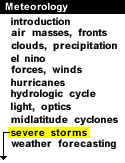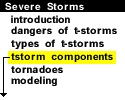
|
Here is another wall cloud on another day, looking north-northeast from about 6 miles away. This wall cloud was rotating, but periodically seemed to become undercut by outflow and lose its rotational characteristics. The storm was severe, and Doppler radar near Norman, Oklahoma, did indicate a mesocyclone, but no tornadoes developed.

Photograph by: Doswell
We have emphasized that many thunderstorms are hybrids and contain characteristics of several of the storm classification groups that we have discussed. These storms will be difficult to warn for. The forecaster needs all the pertinent radar and spotter information that he/she can get to make an appropriate warning decision. In the case of this last storm, a tornado warning is quite probably justified, even though no tornadoes occurred. With some of the weaker wall cloud storms that we have shown, a severe thunderstorm warning likely would suffice.

Photograph by: Moller
Looking east from about 5 miles away, a furiously rotating wall cloud was moving northeast across the forests east of Logansport, Louisiana. Spotting in the southeast and east U.S. is more difficult because of trees, hills, and typically hazy conditions.
However, the basic building blocks of storms are the same in these areas as they are around the world, although some regional differences do exist in storm structure detail. In fact, the first study of a supercell was from England, with subsequent studies coming from the Soviet Union, Canada and the United States. This storm did produce large hail, but lack of access into the affected forest areas precluded positive identification of a tornado touchdown.

cyclic wall clouds |
|

Tornadoes |





